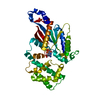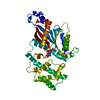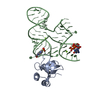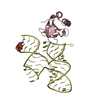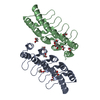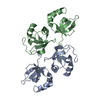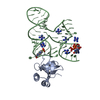[English] 日本語
 Yorodumi
Yorodumi- SASDAT6: Integrin beta4, fragment of the cytoplasmic region encompassing t... -
+ Open data
Open data
- Basic information
Basic information
| Entry | Database: SASBDB / ID: SASDAT6 |
|---|---|
 Sample Sample | Integrin beta4, fragment of the cytoplasmic region encompassing the third and fourth FnIII domains
|
| Function / homology |  Function and homology information Function and homology informationType I hemidesmosome assembly / nail development / hemidesmosome assembly / hemidesmosome / peripheral nervous system myelin formation / trophoblast cell migration / skin morphogenesis / Laminin interactions / filopodium assembly / mesodermal cell differentiation ...Type I hemidesmosome assembly / nail development / hemidesmosome assembly / hemidesmosome / peripheral nervous system myelin formation / trophoblast cell migration / skin morphogenesis / Laminin interactions / filopodium assembly / mesodermal cell differentiation / Differentiation of Keratinocytes in Interfollicular Epidermis in Mammalian Skin / integrin complex / Assembly of collagen fibrils and other multimeric structures / Syndecan interactions / cell adhesion mediated by integrin / cell leading edge / basement membrane / basal plasma membrane / cell-matrix adhesion / integrin-mediated signaling pathway / cell motility / G protein-coupled receptor binding / cell-cell adhesion / response to wounding / autophagy / integrin binding / cell junction / cell migration / nuclear membrane / receptor complex / cell adhesion / focal adhesion / nucleolus / cell surface / extracellular exosome / metal ion binding / plasma membrane Similarity search - Function |
| Biological species |  Homo sapiens (human) Homo sapiens (human) |
 Citation Citation |  Journal: Acta Crystallogr D Biol Crystallogr / Year: 2015 Journal: Acta Crystallogr D Biol Crystallogr / Year: 2015Title: Combination of X-ray crystallography, SAXS and DEER to obtain the structure of the FnIII-3,4 domains of integrin α6β4. Authors: Noelia Alonso-García / Inés García-Rubio / José A Manso / Rubén M Buey / Hector Urien / Arnoud Sonnenberg / Gunnar Jeschke / José M de Pereda /    Abstract: Integrin α6β4 is a major component of hemidesmosomes that mediate the stable anchorage of epithelial cells to the underlying basement membrane. Integrin α6β4 has also been implicated in cell ...Integrin α6β4 is a major component of hemidesmosomes that mediate the stable anchorage of epithelial cells to the underlying basement membrane. Integrin α6β4 has also been implicated in cell proliferation and migration and in carcinoma progression. The third and fourth fibronectin type III domains (FnIII-3,4) of integrin β4 mediate binding to the hemidesmosomal proteins BPAG1e and BPAG2, and participate in signalling. Here, it is demonstrated that X-ray crystallography, small-angle X-ray scattering and double electron-electron resonance (DEER) complement each other to solve the structure of the FnIII-3,4 region. The crystal structures of the individual FnIII-3 and FnIII-4 domains were solved and the relative arrangement of the FnIII domains was elucidated by combining DEER with site-directed spin labelling. Multiple structures of the interdomain linker were modelled by Monte Carlo methods complying with DEER constraints, and the final structures were selected against experimental scattering data. FnIII-3,4 has a compact and cambered flat structure with an evolutionary conserved surface that is likely to correspond to a protein-interaction site. Finally, this hybrid method is of general application for the study of other macromolecules and complexes. |
 Contact author Contact author |
|
- Structure visualization
Structure visualization
| Structure viewer | Molecule:  Molmil Molmil Jmol/JSmol Jmol/JSmol |
|---|
- Downloads & links
Downloads & links
-Data source
| SASBDB page |  SASDAT6 SASDAT6 |
|---|
-Related structure data
- External links
External links
| Related items in Molecule of the Month |
|---|
-Models
| Model #219 |  Type: dummy / Software: DAMMIF / Radius of dummy atoms: 1.50 A / Chi-square value: 1.976836  Search similar-shape structures of this assembly by Omokage search (details) Search similar-shape structures of this assembly by Omokage search (details) |
|---|---|
| Model #220 |  Type: atomic / Software: CRYSOL / Chi-square value: 1.297321  Search similar-shape structures of this assembly by Omokage search (details) Search similar-shape structures of this assembly by Omokage search (details) |
- Sample
Sample
 Sample Sample | Name: Integrin beta4, fragment of the cytoplasmic region encompassing the third and fourth FnIII domains Specimen concentration: 1.50-48.60 |
|---|---|
| Buffer | Name: Sodium Phosphate / Concentration: 20.00 mM / pH: 7.5 / Composition: 150 mM NaCl, 5% glycerol, 3 mM DTT |
| Entity #133 | Type: protein / Description: Integrin beta-4 / Formula weight: 23.359 / Num. of mol.: 1 / Source: Homo sapiens / References: UniProt: P16144 Sequence: GSHMVPDTPT RLVFSALGPT SLRVSWQEPR CERPLQGYSV EYQLLNGGEL HRLNIPNPAQ TSVVVEDLLP NHSYVFRVRA QSQEGWGRER EGVITIESQV HPQSPLCPLP GSAFTLSTPS APGPLVFTAL SPDSLQLSWE RPRRPNGDIV GYLVTCEMAQ GGGPATAFRV ...Sequence: GSHMVPDTPT RLVFSALGPT SLRVSWQEPR CERPLQGYSV EYQLLNGGEL HRLNIPNPAQ TSVVVEDLLP NHSYVFRVRA QSQEGWGRER EGVITIESQV HPQSPLCPLP GSAFTLSTPS APGPLVFTAL SPDSLQLSWE RPRRPNGDIV GYLVTCEMAQ GGGPATAFRV DGDSPESRLT VPGLSENVPY KFKVQARTTE GFGPEREGII TIES |
-Experimental information
| Beam | Instrument name: PETRA III P12 / City: Hamburg / 国: Germany  / Type of source: X-ray synchrotron / Wavelength: 0.12 Å / Dist. spec. to detc.: 3.1 mm / Type of source: X-ray synchrotron / Wavelength: 0.12 Å / Dist. spec. to detc.: 3.1 mm | |||||||||||||||||||||
|---|---|---|---|---|---|---|---|---|---|---|---|---|---|---|---|---|---|---|---|---|---|---|
| Detector | Name: Pilatus 2M | |||||||||||||||||||||
| Scan |
| |||||||||||||||||||||
| Distance distribution function P(R) |
| |||||||||||||||||||||
| Result | Comments: Combined use of SAXS, crystal structures, site directed spin labeling, double electron-electron resonance (DEER), and molecular modeling to analyze the structure of FnIII-3,4.
|
 Movie
Movie Controller
Controller




